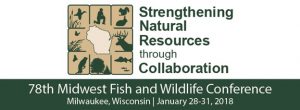 One of the Midwest Glacial Lakes Partnership’s primary objectives is to share science and management to improve and protect inland lake fish habitat across the region. Too often, boundaries between organizations become boundaries to information flow, and these boundaries hinder the ability of scientists, managers, and practitioners to accomplish their goals. An advantage of the Partnership is the opportunity to share experiences across organizations and learn from others. Through these conversations it became clear that there was a need for sharing recommendations for managing inland lake fish habitat. To address this issue, the Partnership organized a symposium at the 78th Midwest Fish and Wildlife Conference in Milwaukee, WI.
One of the Midwest Glacial Lakes Partnership’s primary objectives is to share science and management to improve and protect inland lake fish habitat across the region. Too often, boundaries between organizations become boundaries to information flow, and these boundaries hinder the ability of scientists, managers, and practitioners to accomplish their goals. An advantage of the Partnership is the opportunity to share experiences across organizations and learn from others. Through these conversations it became clear that there was a need for sharing recommendations for managing inland lake fish habitat. To address this issue, the Partnership organized a symposium at the 78th Midwest Fish and Wildlife Conference in Milwaukee, WI.
The “Managing fish habitat and fisheries affected by habitat in inland glacial lakes” symposium hosted ten speakers, each of which presented a review of current research and management on an important information gap below.
- Joe Nohner and coauthors discussed the benefits of using landscape ecological approaches to prioritize and inform lake management, using the Midwest Glacial Lakes Partnerships’ upcoming Phase II Assessment of Inland Lake Fish Habitats as an example of how such an approach could be implemented.
- Catherine Hein reviewed literature and field-experiences on efforts to prevent and/or reverse eutrophication, offering case studies to illustrate successful methods and avoid common pitfalls.
- Ralph Tingley and coauthors presented a framework for climate change adaptation in Midwest glacial lakes and highlighted strategies that have been implemented throughout the region.
- Nick Phelps identified the importance of understanding the environmental factors that contribute to fish kills and created models to predict future fish kills based on water temperature, primary productivity, human disturbance, and other factors.
- Jim Breck and coauthors presented models of bluegill growth based on landscape-scale drivers of fish habitat.
- Josh Raabe and coauthors reviewed the Walleye literature on how inland lake habitat may influence successful natural reproduction and stocking efforts and highlight remaining critical research questions.
- Greg Sass and coauthors presented research results from a series of coarse woody habitat additions and removals to inland lake littoral zones, highlighting issues related to production vs. attraction of fishes, the benefits of coarse woody habitat to different species, whether the effects of coarse woody habitat differ from fish cribs, and whether angler behavior and success are influenced by these habitats.
- Paul Radomski discussed techniques for aquatic plant inventory and monitoring, management options for aquatic plant protection, non-indigenous species control, and potential research opportunities to better understand aquatic plant and fish relationships.
- Jonathan Hansen provided a synopsis of aquatic plant management permitting in Minnesota, a program that balances the desires of lakeshore property owners and the need to conserve habitat for aquatic animals.
- Patrick Goggin and Pamela Toshner provided an overview of the Healthy Lakes Initiative in Wisconsin, whereby lakefront property owners are provided technical and financial assistance to implement specific best management practices to improve lake health.
The Midwest Glacial Lakes Partnership and authors associated with this symposium are currently pursuing publication options to share the information from this symposium broadly with project partners.

